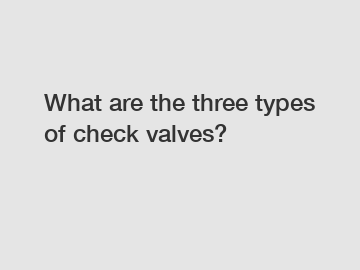What are the three types of check valves?
Check valves play a crucial role in the fluid control systems of various industries, providing a reliable method for managing the flow of liquids and gases. Within this category of valves, there are three distinct types that each fulfill specific purposes and offer unique advantages. In this blog post, we will dive deep into these three types, exploring their functionalities, applications, and benefits. Get ready to discover the fascinating world of check valves!
1. Swing Check Valves:
Swing check valves are among the most common types utilized in fluid control systems. These valves consist of a hinged disc or flap that opens in the direction of the fluid flow and closes automatically to prevent backflow. The swinging action of the disc allows for smooth flow when the pressure is in the forward direction and instantly seals off the flow when pressure is reversed.

Applications of swing check valves span across a range of industries, including water supply networks, heating and cooling systems, wastewater treatment plants, and oil and gas pipelines. These valves excel in applications where quick and reliable closure is essential to prevent the reversal of flow, ensuring system efficiency and integrity.
Advantages of swing check valves:
- High flow capacity due to the unrestricted opening provided by the swinging disc.
- Low-pressure drop across the valve, minimizing energy consumption.
- Versatility in installation position, allowing horizontal or vertical mounting.
- Suitable for both low and high-pressure applications.
2. Lift Check Valves:
Lift check valves, also known as piston check valves, feature a disc or piston that moves vertically to control flow. When fluid pressure exceeds that of the valve's spring or counterweight, the disc lifts, allowing flow. Once the pressure equalizes or drops below the threshold, the disc settles back into its seat, preventing backflow.
These valves find extensive application in steam systems, boiler feedwater control, and other processes with high-velocity flow conditions. Their robust construction, capable of withstanding high-pressure differentials, makes them ideal for critical operations where tight sealing is crucial.
Advantages of lift check valves:
- Strong resistance to water hammering due to the controlled motion of the disc.
- Suitable for high-pressure systems, capable of handling heavy-duty applications.
- Minimal pressure loss across the valve, optimizing system efficiency.
- Wide array of sizes and materials available to cater to diverse industry requirements.
3. Ball Check Valves:
Ball check valves employ a spherical ball, often made of resilient materials such as rubber or thermoplastics, to regulate the flow of fluids. The ball rests against the seat or opening, blocking backflow, and is forced away from the seat when fluid pressure exceeds the forward threshold.
This type of check valve is prominent in applications that demand quick response times, minimal backflow, and compatibility with a wide range of fluids. Ball check valves are extensively used in industries such as pharmaceuticals, chemical processing, and water treatment, among others.
Advantages of ball check valves:
- Rapid response to changes in flow conditions, minimizing the risk of reverse flow.
- Excellent sealing properties due to the tightly fitted ball against the seat.
- Compatible with different fluid types, including corrosive substances.
- Compact design, making them suitable for installations in tight spaces.
Conclusion:
Check valves are indispensable components in fluid control systems, ensuring efficient and safe operations across various industries. Understanding the functionalities and applications of the three main types - swing check valves, lift check valves, and ball check valves - empowers industry professionals to select the most suitable option for their specific needs.
Whether it is preventing water hammering in heating systems, achieving tight sealing in steam processes, or maintaining process integrity in chemical plants, each type of check valve offers unique benefits. By leveraging their distinctive characteristics, engineers and system designers can optimize the performance and reliability of fluid control systems.
Remember, selecting the right check valve involves considering factors such as fluid properties, expected flow rates, and pressure differentials. Always consult with industry experts or trusted suppliers to ensure you make an informed decision that aligns with your specific requirements.
For more dispensing closure, dispensing closure, dispensing closureinformation, please contact us. We will provide professional answers.
222
0
0

Comments
All Comments (0)